NETHERLANDS
Society

Society
Cities in NETHERLANDS
| Amsterdam | Eindhoven | Maastricht |
| Rotterdam | The hague |
Society
State structure
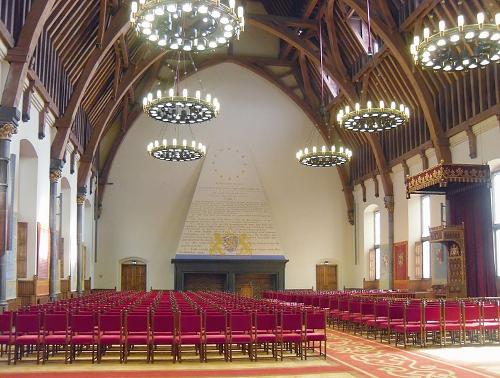 The Ridderzaal of the Binnenhof, The HaguePhoto: Jan Arkesteijn CC 3.0 Unported no changes made
The Ridderzaal of the Binnenhof, The HaguePhoto: Jan Arkesteijn CC 3.0 Unported no changes made
The Kingdom of the Netherlands is formally a constitutional, hereditary monarchy in which the separation of powers is largely regulated in the Constitution. Constitutional law, the Netherlands is a parliamentary democracy in which the king is inviolable and the ministers are responsible.
Legislative power is exercised by the government and the States General. The Houses of the States General, the Senate and the House of Representatives, represent the Dutch people and have existed since 1815. The Senate has 75 members and the House of Representatives has 150 members.
The Constitution establishes both the principle of universal suffrage and proportional representation. The House of Representatives is directly elected every four years by those entitled to vote, which are all Dutch citizens aged 18 or older. The members of the Senate are elected by the Provincial Council through multi-stage elections. Elections for the Provincial Council are also held every four years.
Executive power rests with the King and is concentrated with the ministers who are head of ministerial departments, over which the entire central government is divided. The general advisory body for the King is the Council of State. The Council of State must be heard with every bill. The head of state is the chairman of the Council of State, which consists of a vice-president and a maximum of 28 members. Day-to-day management rests with the vice president. The capital of the Netherlands is Amsterdam, but the government has its seat in The Hague.
Judicial power is exercised by independent judges, appointed for life by the King. Jurisprudence in civil and criminal cases rests with subdistrict courts, district courts, courts of justice and the Supreme Court of the Netherlands, the highest civil and criminal court in the Netherlands. The Supreme Court has the power to set aside judgments of army judges.
The General Audit Chamber, which consists of three members, supervises the financial management of government resources.
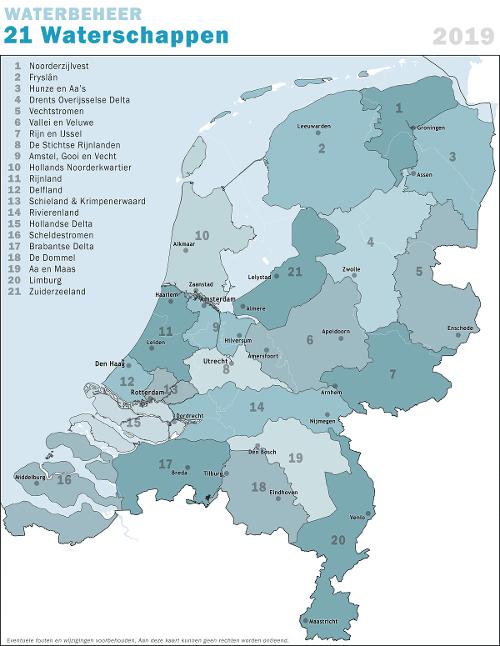 Water boards NetherlandsPhoto: Janwillemvanaalst CC 4.0 International no changes made
Water boards NetherlandsPhoto: Janwillemvanaalst CC 4.0 International no changes made
The Dutch territory is divided into water boards that provide water management and are generally responsible for defending the country against water. The water boards are responsible for, among other things, irrigation, drainage, water purification and maintenance of canals and rivers. The general management is elected by home and land owners within the area of the water board. The executive committee and the chairman, the dijkgraaf, are appointed by the government.
The constitution of the Netherlands Antilles is regulated in a Constitution by virtue of the Statute for the Kingdom of the Netherlands of 1954. The King of the Netherlands is represented as head of the government of the Netherlands Antilles by a governor appointed by him. This is at the same time an organ of the Kingdom and an organ of the Netherlands Antilles. Its powers as an organ of the Kingdom are regulated by or pursuant to the Statute.
The governor exercises government together with the Council of Ministers, whose members (in total eight) are appointed by him and are responsible to Parliament (Parliament). Furthermore, an Advisory Board is at his side. Legislative power is exercised by the governor with the States (22 members: 14 from Curaçao, 3 from Bonaire, 3 from St. Maarten, 1 from Saba and 1 from St. Eustatius), elected by universal suffrage for four years and representing the entire people of the Netherlands Antilles.
The regulatory powers of the bodies of the Netherlands Antilles only relate to so-called National Affairs. The Kingdom Statute defines what Kingdom affairs are. The Netherlands Antilles are administratively divided into five Island Territories, namely Bonaire, Curaçao, Saba, St. Eustatius and St. Maarten.
Administrative division, provincial and municipal administration
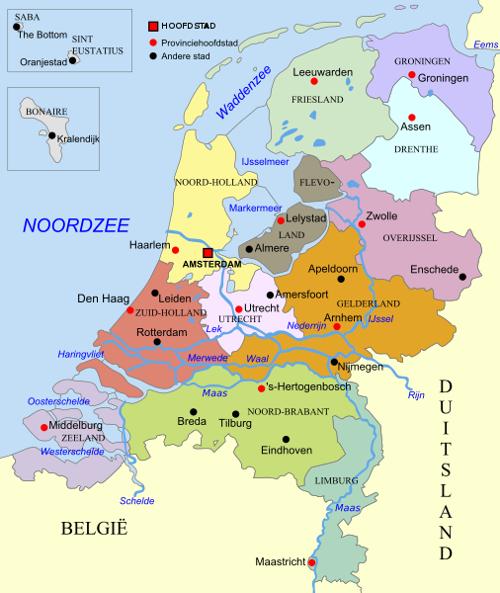 Map of the Netherlands with Provinces and capitals of provincesPhoto: Hans Erren CC 3.0 Unported no changes made
Map of the Netherlands with Provinces and capitals of provincesPhoto: Hans Erren CC 3.0 Unported no changes made
The Netherlands is divided into twelve provinces and 636 municipalities. The number of municipalities varies considerably due to continuous municipal reorganisations. The provinces are governed by the Provincial Council and the Provincial Council elect an executive committee from their midst, the Provincial Executive. The Chairman of the Provincial and Provincial Executive is the Queen's Commissioner appointed by the Crown.
The municipalities are headed by the municipal council, which is chaired by a mayor appointed by the Crown and is appointed for a period of six years. This, together with the aldermen, forms the daily management. Until recently, the councilors were elected from and by the council. Nowadays aldermen can also be elected from "outside". Municipal elections take place every four years. In the 2002 municipal council elections, citizens in two places could also participate in a referendum for an elected mayor. The municipalities of Best and Vlaardingen received a D66 member and a PvdA member respectively as mayor.
Royal house
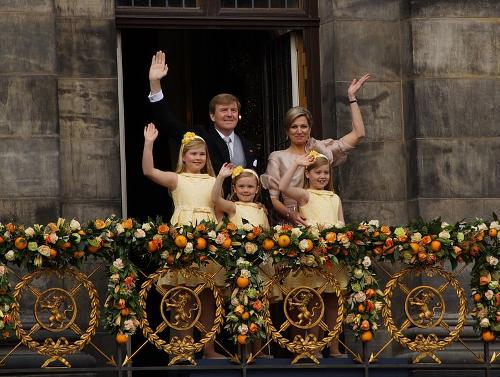 King Willem-Alexander, Queen Maxima and the PrincessesPhoto: Floris Looijesteijn CC 2.0 Generic no changes made
King Willem-Alexander, Queen Maxima and the PrincessesPhoto: Floris Looijesteijn CC 2.0 Generic no changes made
The House of Orange is the Dutch royal house. This royal family has been connected with the Netherlands since the sixteenth century and the ancestor is Prince William of Orange (1533-1584).
Queen Beatrix has been the head of state since 1980 and succeeded her mother, now Princess Juliana. Queen Beatrix was married to Prince Claus of the Netherlands, Jonkheer van Amsberg, who died on October 6, 2002. The eldest son of Beatrix and Claus, Willem-Alexander, is the intended heir to the throne. In 2002 he married the Argentinian Máxima Zorreguieta. Kingship is hereditary in both male and female lines, with the oldest child having precedence. Willem-Alexander succeeds his mother Beatrix in 2013.
Political parties
 Second chamber seat number of political parties from 1888-2017, NetherlandsPhoto: Harmenator CC 4.0 International no changes made
Second chamber seat number of political parties from 1888-2017, NetherlandsPhoto: Harmenator CC 4.0 International no changes made
Political parties are very important to the Dutch political system. All parties represented in the States General date from after the Second World War, but are often a continuation of the pre-war political parties or movements. Until the mid-1970s, the three main philosophical movements in the Netherlands were: the confessional, the socialist and the liberal.
As a result of a complex of causes, these philosophies lost their power of inspiration, but the political parties based on them managed to maintain themselves through mergers and changes in direction.
The Christian Democratic Appeal (CDA), which emerged from a 1977 amalgamation of the Catholic People's Party (KVP), Anti-Revolutionary Party (ARP) and Christian Historical Union (CHU), initially attracted mostly denominational voters, but since the middle of the In the eighties the CDA was also able to attract non-ecclesiastical voters because it distanced itself more from the churches and the confessional organizations and chose a position on the right of the political center. After the 1989 elections, the Christian Democrats managed to stay in power for the fourth consecutive time.
In 1994 the confessionals ended up in opposition for the first time in their history. The Social Democratic Labor Party (PvdA), often the coalition partner of the confessional since World War II, forged a non-denominational, so-called "Purple" coalition with the liberal People's Party for Freedom and Democracy for the first time since 1919 in 1994. (VVD) and Democrats '66 (D66). This party, founded in 1966 to blow up the existing political system, developed more and more into an established party over time and experienced spectacular growth, especially in the second half of the eighties. After the 2002 elections, however, D66 gained only eight seats.
At the end of the eighties a new group was formed, Groen Links; originated from a combination of small left-wing parties, namely the Communist Party of the Netherlands (CPN), the Pacifist-Socialist Party (PSP), the Evangelical People's Party (EPP) and the Political Party Radikalen (PPR). Apart from this, also on the left, is the Socialist Party (SP).
In addition, a number of small political parties on the right side of the political center have continued to exist, namely the Staatkundig Gereformeerde Feest (SGP), the Reformed Political Association (GPV) and the Reformatorische Politische Federatie (RPF). The last two parties currently form the Christian Union.
In addition to nationally operating parties, many local parties and advocacy organizations are active, particularly at municipal level, whose influence and support is gradually diminishing in favor of the national parties.
In the nineties of the last century, the so-called "Liveable" parties emerged strongly, including in Hilversum led by Jan Nagel, a former PVDA politician. Nagel, among others, founded the national party Liveable Netherlands, which competes in the 2002 national elections. The popular Pim Fortuyn was brought in as the party leader. After a controversial interview in de Volkskrant, in which Fortuyn distanced himself from the party line, Fortuyn stepped up and founded his own party, the List Pim Fortuyn. In the polls before the elections it appeared that the LPF could count on 20 to 30 seats. On May 6, 2002, Pim Fortuyn was shot. A week later, elections to the Dutch parliament were held and the LPF gained 26 seats, making it the second party in the country. After many skirmishes on the right side of the political spectrum, Geert Wilders' PVV attracts many voters with anti-Islam and anti-Europe views from 2010 onwards.
The current political situation is described in the chapter history.
Education
General
The freedom of education is enshrined in the 1848 Constitution. This means that groups in Dutch society are allowed to found a school on the basis of a religious, ideological or pedagogical-didactic basis. The Netherlands also has, for example, Protestant Christian, Roman Catholic, Jewish, Islamic and free schools.
Schools on a pedagogical-didactic basis are Montessori, Dalton and Jenaplan schools or a combination of these. Schools founded by the government are called public schools. All other schools, founded by private individuals, are called special schools.
Compulsory education applies to children aged five to eighteen. Partial compulsory education applies for the last two years.
Education system
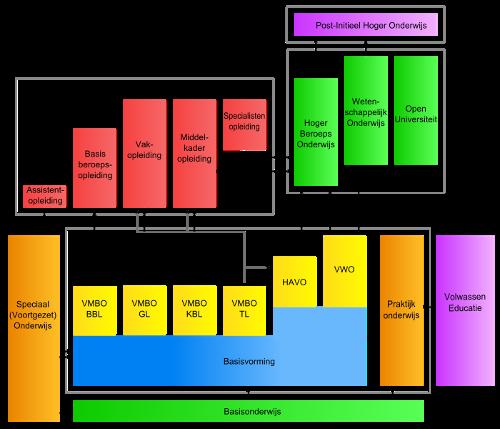 Education System in the NetherlandsPhoto: JrPol CC 3.0 Unported no changes made
Education System in the NetherlandsPhoto: JrPol CC 3.0 Unported no changes made
The Dutch education system can be divided into three levels: primary, secondary and tertiary education.
Primary or basic education is intended for children from four to twelve years old. This phase in education is made up of eight year classes, called groups, and focuses on the creative, mental and emotional development of the children. Much attention is also paid to acquiring sufficient social, cultural and physical skills.
Almost 100% of all children attend primary education and continue on to secondary or secondary education.
Primary education also includes special primary and secondary education for children aged 3 to 20 with a mental, physical and / or social disability. By taking extra care of these children, we try to get them entering regular education.
Every day, more than 1.5 million children attend primary or special education.
In the eighth and last group of primary education, the pupil takes a test, usually the CITO test, on the basis of which he or she is advised on which form of secondary education he or she can best follow.
Secondary education consists of:
VMBO: Preparatory Secondary Vocational Education. The duration is four years and prepares you for secondary vocational education (SBO, formerly MBO);
HAVO: Higher General Education. The duration is five years and prepares students for higher professional education (HBO);
VWO: Preparatory Scientific Education (VWO).
The duration is 6 years and prepares for academic education (WO).
VMBO is a new type of school that was introduced from 1 August 1999. This type of education consists of so-called "learning paths", which gradually replaced the VBO (Preparatory Vocational Education) and the MAVO (Middle General Secondary Education). The VMBO has four learning paths with fixed subject packages, and the students choose one of those learning paths.
The four learning paths are:
The theoretical learning path
The mixed learning path
The management profession-oriented learning path
The basic job-oriented learning path
Pupils in VMBO first follow two years of basic education, which means that all students receive the same broad range of subjects.
In most cases, pupils in HAVO and VWO follow three years of basic education in the same subjects, after which they definitively choose HAVO or VWO. In the basic curriculum, the students are taught in fifteen subjects. In addition, each school can offer other subjects.
HAVO lasts five years and is mainly intended as preparation for HBO. Pre-university education lasts six years and is mainly intended as preparation for university education. Pre-university education includes the atheneum and gymnasium. At the gymnasium, all pupils receive Greek and Latin in the lower years and Greek and / or Latin in the upper years. There are also high schools where children choose the gymnasium or the atheneum themselves.
The superstructure HAVO (classes 4 and 5) and VWO (classes 4, 5 and 6) has been renewed and is now called the Second Phase. Profiles in the Second Phase replace the free choice of subjects. In this way an attempt is made to improve the connection between secondary and higher education. The pupils can choose from the profiles culture and society, economy and society, nature and health and nature and technology.
A second major change is the study house in which the pupils increasingly plan their own studies and carry out assignments and make assignments more independently and in groups. This also increases independence and improves the connection with higher education.
Higher professional education, along with academic education, is part of higher education. Since 1993, colleges and universities have been subject to the same legislation: the Higher Education and Scientific Research Act (WHW).
HBO is characterized by diversity: there are approximately 200 different courses for various professions in different social fields. There are broad and more specialized courses. There are large universities of applied sciences with a varied range of study programs, but also medium-sized and small ones with a limited range. Mergers have reduced the number of universities of applied sciences from nearly 350 in the mid-1980s to 56 in 2000.
The courses are divided into seven CROHO components: Education, Technology, Health Care, Economy, Behavior & Society, Language & Culture and Agriculture. The Open University (distance education) is also part of academic education.
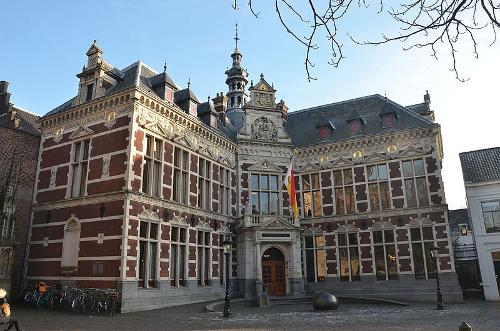 The Academy Building of Utrecht University, NetherlandsPhoto: Steven Lek CC 4.0 International no changes made
The Academy Building of Utrecht University, NetherlandsPhoto: Steven Lek CC 4.0 International no changes made
Scientific education trains students to practice science independently or prepares them for social relations for which scientific training is required. In addition to offering scientific education, universities also conduct scientific research. After completing the first phase of academic education, students can focus on further specialization, research or preparation for the PhD.
Graduates of a university may use the title engineer (ir), doctorandus (drs) or master of law (mr). Whoever graduates may use the title doctor (dr). These titles are legally determined and protected.
The Netherlands has the following universities:
University of Leiden
University of Utrecht
University of Groningen
Erasmus University Rotterdam
University of Maastricht
Vrije Universiteit Amsterdam
University of Amsterdam
Catholic University of Nijmegen
Catholic University of Brabant (Tilburg)
Delft University of Technology
Eindhoven University of Technology
University of Twente (Enschede)
Wageningen University
Open University (Heerlen)
Sources
Haafkens, M. / Nederland
Gottmer
Harmans, G.L.M. / Nederland
Van Reemst
Metze, M. / De staat van Nederland
SUN
Ver Berkmoes, R. / Netherlands
Lonely Planet
CIA - World Factbook
BBC - Country Profiles
Last updated November 2025Copyright: Team The World of Info